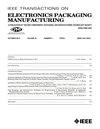Optimizing SMT Performance Using Comparisons of Efficiency Between Different Systems Technique in DEA
IEEE Transactions on Electronics Packaging Manufacturing
Pub Date : 2009-09-15
DOI:10.1109/TEPM.2009.2029238
引用次数: 35
Abstract
Surface-mount-technology (SMT) enables production of reliable printed circuit board at a reduced weight, volume, and cost. Nevertheless, SMT defects increase quality costs and deteriorate performance. In reality, defects are not equally important and their corresponding quality costs vary. In these regards, this research divides SMT defects into three classes; minor, major, and serious. Eight key factors from SMT processes are investigated concurrently with L18(21 times 37) array. Taguchi's accumulation analysis method is first applied and it provides incomplete optimal levels for some factor. In this research, each experiment is treated as a decision making unit (DMU) with defect counts set as inputs. Comparisons of efficiency between different systems (CEBDS) technique in data envelopment analysis (DEA) is then adopted to optimized SMT performance. The corresponding actual improvements in minor, major, and serious defect counts are found 0.352, 2.153, and 4.154 dB, respectively. Analysis of variance (ANOVA) is finally performed to determine significant factor effects. It is found that conveyor speed and reflow temperature are the most influential factors on SMT performance. In conclusion, the CEBDS technique turns out to be an efficient approach for optimizing process performance with categorical data.基于DEA不同系统效率比较的SMT性能优化
表面贴装技术(SMT)能够以更轻的重量、体积和成本生产可靠的印刷电路板。然而,SMT缺陷增加了质量成本并降低了性能。在现实中,缺陷并不是同等重要的,其相应的质量成本也各不相同。为此,本研究将SMT缺陷分为三类;小的,大的,严重的。利用L18(21 × 37)阵列对SMT工艺中的8个关键因素进行了并行研究。田口积累分析法首次被应用,它对某些因素提供了不完全最优水平。在本研究中,将每个实验视为一个决策单元(DMU),并将缺陷计数设置为输入。采用数据包络分析(DEA)中的效率比较(CEBDS)技术对SMT性能进行优化。相应的小缺陷、大缺陷和严重缺陷的实际改进分别为0.352、2.153和4.154 dB。最后进行方差分析(ANOVA)以确定显著因素的影响。研究发现,输送速度和回流温度是影响SMT性能的主要因素。综上所述,CEBDS技术是一种利用分类数据优化过程性能的有效方法。
本文章由计算机程序翻译,如有差异,请以英文原文为准。
求助全文
约1分钟内获得全文
求助全文

 求助内容:
求助内容: 应助结果提醒方式:
应助结果提醒方式:


